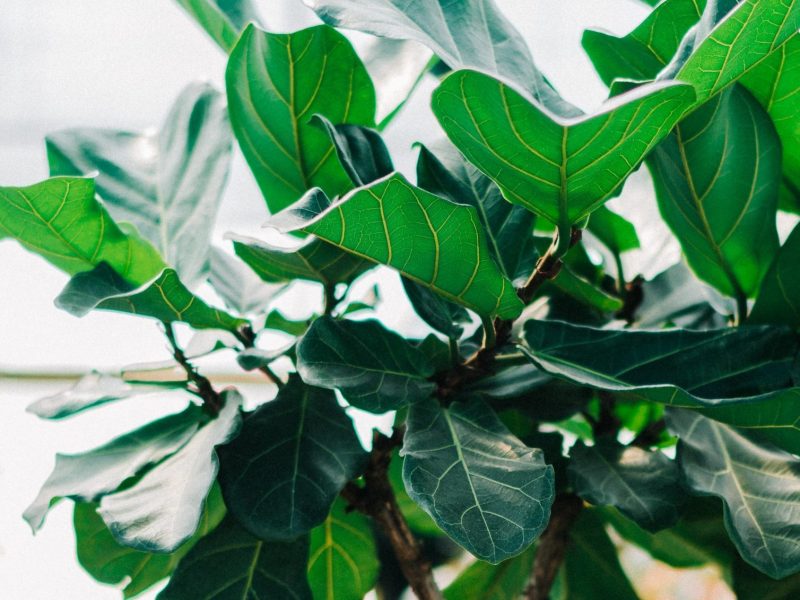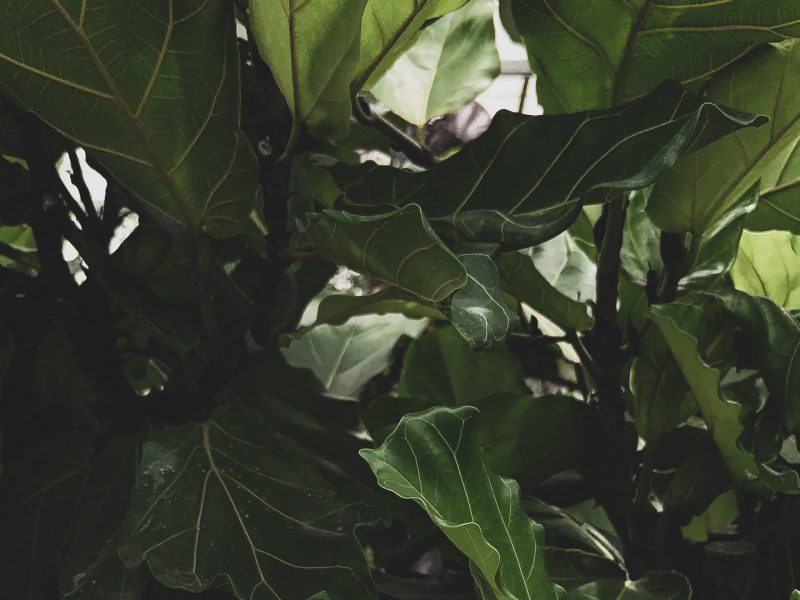
Fiddle Leaf Fig Trees are one of the most popular houseplants at the moment. Their striking and luscious dark green leaves really do make them something special. However, it can be frustrating if your beloved plant starts to droop and you don’t know why! But don’t worry too much as drooping leaves on their own mean you have caught the issue early and the problem can very easily be reversed. The main 5 causes of Fiddle Leaf Fig leaves drooping are underwatering, overwatering, drainage issues, low humidity and shock.
Underwatering can cause drooping leaves
Too little water can harm your Fiddle Leaf Fig in more ways than one. It can cause dry leaves, lack of growth and nutrient deficiency. But one of the earlier signs of underwatering is drooping leaves. If you find that the stems and leaves look a little lifeless, it could be because the soil has been dry for too long. Stick a finger in the top few centimetres of the soil to check the moisture. You can also try lifting your Fiddle Leaf Fig if it’s not that mature to see how light the pot feels. However, be careful with this as if your Fiddle is a few metres tall this can severely hurt your back.
If you find that your Fiddle Leaf Fig feels very dry, water it a little every other day for a week and you should slowly start to see your plant un-droop. Your first instinct might be to give it loads of water straight away but this can actually be harmful to your Fiddle if the soil goes from one extreme to the other. Instead, you want to reintroduce frequent watering for a week or two and this should solve the problem.
Investing in a moisture meter would also be a great idea, these handy little things take all of the guess work away from watering. If you really just want a set it and forget it solution, getting a self watering pot could be the one for you.
Overwatering can also cause drooping leaves
If the drooping leaves are paired with dark brown spots but the leaves aren’t crispy, then overwatering is the most probable cause. Fiddle Leaf Figs are pretty hardy plants and won’t die suddenly if you overwater them once in a while. However, consistent overwatering will mean their leaves will start to droop as their roots begin to rot and turn mushy. Fiddles need to be watered no more than once a week in the hottest months of the year, and less frequently in autumn and winter.
If you think that you may have overwatered your Fiddle Leaf Fig and this is why it’s drooping, it is best to replace the soil straight away rather than just sit and wait for it to dry up over time. Be careful when removing the soil from the roots as you don’t want to cause any further damage.
Make sure to check the moisture in the soil before you water your Fiddle to prevent it drooping in future. There are two really easy ways to make sure that it definitely needs water. First check the moisture at the top of the soil, if it is still damp then wait a few days before watering again. You can also lift up your Fiddle as we mentioned before. Make sure to handle your plant gently when picking it up to prevent any further damage to the leaves or stems.
Self-watering pots and a good moisture meter will make sure that you don’t run into this issue again.
Drooping leaves on your Fiddle Leaf Fig can also indicate drainage issues
Sometimes it may not be your watering schedule that is causing your Fiddle’s leaves to droop and fall off, but the poor draining of the soil and pot. You can very easily increase the amount of drainage by mixing in a small amount of perlite, this will make it far easier for water to flow through and out of the drainage holes of your pots (you should also check to make sure your pots have drainage holes). Another easy step is to add a few small stones or pebbles to the bottom of your pots, this helps in making sure that the drainage holes are never blocked by soil or any loose debris.
Although clay or terracotta pots can be a little bit more expensive or breakable, their upsides are much more than just the aesthetic. The clay they’re made of is permeable which means that some of the water in your soil can evaporate through the sides of the pot. This isn’t the case for the plastic pots that most use, which instead hold in all of that moisture. So sometimes it is worth investing a little more to make sure that the roots of your Fiddle’s roots are not sitting in too much moisture which is causing them to droop.
Low humidity can also cause droopy leaves
If the soil isn’t particularly dry, it could be a lack of humidity that is causing your plant’s leaves to droop. Fiddles like quite humid environments and can struggle in homes with dry air. This can be especially damaging in winter months when we often have the heating on for several hours a day. A lack of humidity in the air can cause the leaves to be a little limp and droop down. There are several ways you can increase the humidity for your Fiddle Leaf Fig:
Misting the leaves
One of the simplest ways to increase the humidity for any of your houseplants is to mist them with a spray bottle a couple of times a week. We love these spray bottles from Amazon because they’re super affordable and look great!
Pebble tray
Place your Fiddle over a tray of pebbles with fresh water over the top. Over the day water from the tray will evaporate giving the plants above exactly what they’re looking for and will go a long way to preventing your Fiddle from drooping.
Give your Fiddle Leaf Fig a shower
To quickly raise the humidity and wash down your Fiddle of any long-standing dust, you can always give them a quick shower. Simply pop them in the shower and wash them down with lukewarm water, this will clean off the leaves and give the soil a good soaking.
Move your Fiddle to the bathroom
If you’re lucky enough to have great lighting in your bathroom you can move your Fiddle in there to increase the humidity and stop the leaves from drooping. The running water from your showers means your bathroom is probably one of the most humid in your home.
Buy a humidifier
They’re relatively affordable little devices and they make keeping a consistent humidity level so much easier. Most will allow you to place them on a timer so they run on a fixed schedule, and some will even have a built-in monitor so they automatically turn on and off to keep the humidity exactly where you want it. This is our favourite humidifier from Amazon, it does a great job of keeping some humidity in through the colder/dryer months.
Want to know more about how to raise the humidity for your Fiddle Leaf Fig Tree and other houseplants? We have written a whole guide on this.
Transplant shock/environment change might also be the cause
Just like humans, Fiddle Leaf Fig Trees can get a little stressed out when they move home. In their case moving home can be as simple as moving to a new, bigger pot. Signs such as drooping leaves after repotting are totally normal. It may take a few days for the signs to appear but in the right environment, with the right care, it should only take a few weeks for your plant to get used to the new pot and get back to normal. Keep an eye on your Fiddle after repotting to make sure that the signs do not continue for too long.
Your Fiddle may also show signs of stress if it has been moved to a new spot in your home. A sudden change in light conditions or temperature may cause your Fiddle to go into shock. If your plant is still receiving enough light, and the temperature change is not too extreme, then it should settle into its new home nicely after a few weeks. If you have moved home, the bumps it may have encountered in the process might have also caused a few leaves to droop but it shouldn’t be anything to worry about long term.
Be careful about placing your plant near any ac/heating vents or radiators. The drafts or heat pockets that are created will also cause your Fiddle to display signs of stress, drooping leaves being one of these signs. You could get yourself a handy little humidity monitor, they’re particularly handy for finding the dry spots in your home.
If your Fiddle’s leaves are drooping, but none (or very few) have fallen off, then you’re in luck as you should have caught the issue quick enough to be able to reverse it pretty easily. Once you have diagnosed the issue and rectified the environment or care, your plant should return to full health after a few weeks. If it has lost a lot of leaves and you have only just noticed, don’t worry as with the right care, there is no reason why you can’t revive your dying Fiddle. It may just take a little longer and require a closer eye.














